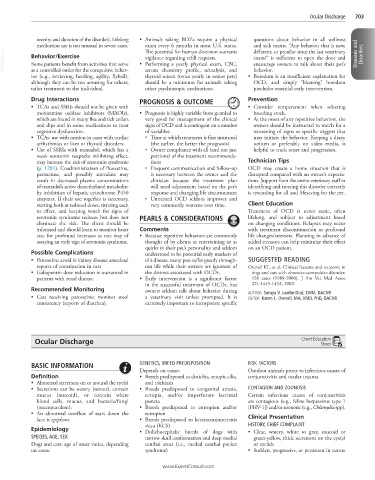Page 1392 - Cote clinical veterinary advisor dogs and cats 4th
P. 1392
Ocular Discharge 703
severity and duration of the disorder). Lifelong • Animals taking BDZs require a physical questions about behavior in all wellness
medication use is not unusual in severe cases. exam every 6 months in most U.S. states. and sick exams. “Any behavior that is new,
VetBooks.ir Behavior/Exercise • Performing a yearly physical exam, CBC, exam?” is sufficient to open the door and Diseases and Disorders
different, or peculiar since the last veterinary
The potential for human diversion warrants
vigilance regarding refill requests.
encourage owners to talk about their pet’s
Some patients benefit from activities that serve
behavior.
as a controlled outlet for the compulsive behav-
thyroid screen (twice yearly in senior pets)
ior (e.g., retrieving, herding, agility, flyball), serum chemistry profile, urinalysis, and • Boredom is an insufficient explanation for
although they can be too arousing for others; should be a minimum for animals taking OCD, and simply “blaming” boredom
tailor treatment to the individual. other psychotropic medications. precludes essential early intervention.
Drug Interactions PROGNOSIS & OUTCOME Prevention
• TCAs and SSRIs should not be given with • Consider temperament when selecting
monoamine oxidase inhibitors (MAOIs), • Prognosis is highly variable from guarded to breeding stock.
which are found in many flea and tick collars very good for management of the clinical • At the onset of any repetitive behaviors, the
and dips and in some medications to treat signs of OCD and is contingent on a number owners should be instructed to watch for a
cognitive dysfunction. of variables: worsening of signs or specific triggers that
• TCAs: use with caution in cases with cardiac ○ Time at which treatment is first instituted may initiate the behavior. Keeping a diary,
arrhythmias or liver or thyroid disorders. (the earlier, the better the prognosis) written or preferably on video media, is
• Use of SSRIs with tramadol, which has a ○ Owner compliance with all (and not just helpful to track onset and progression.
weak serotonin reuptake inhibiting effect, portions) of the treatment recommenda-
may increase the risk of serotonin syndrome tions Technician Tips
(p. 1281). Coadministration of fluoxetine, ○ Frequent communication and follow-up OCD may create a home situation that is
paroxetine, and possibly sertraline may is necessary between the owner and the disrupted compared with an owner’s expecta-
result in decreased plasma concentrations clinician because the treatment plan tions. Support from the entire veterinary staff in
of tramadol’s active demethylated metabolite will need adjustment based on the pet’s identifying and treating this disorder correctly
by inhibition of hepatic cytochrome P450 response and changing life circumstances is rewarding for all and lifesaving for the pet.
enzymes. If their use together is necessary, ○ Untreated OCD seldom improves and
starting both at reduced doses, titrating each very commonly worsens over time. Client Education
to effect, and keeping watch for signs of Treatment of OCD is never static, often
serotonin syndrome reduces but does not PEARLS & CONSIDERATIONS lifelong, and subject to adjustment based
eliminate the risk. The client should be on changing conditions. Relapses may occur
informed and should learn to monitor heart Comments with treatment discontinuation or profound
rate for profound increases as one way of • Because repetitive behaviors are commonly life changes/stressors. Planning in advance of
assaying an early sign of serotonin syndrome. thought of by clients as entertaining or as added stressors can help minimize their effect
quirks in their pet’s personality and seldom on an OCD patient.
Possible Complications understood to be potential early markers of
• Paroxetine: avoid in kidney disease; anecdotal this disease, many pets suffer greatly through- SUGGESTED READING
reports of constipation in cats out life while their owners are ignorant of Overall KL, et al: Clinical features and outcome in
• Gabapentin dose reduction is warranted in the distress associated with OCDs. dogs and cats with obsessive-compulsive disorder:
patients with renal disease. • Early intervention is a significant factor 126 cases (1989-2000). J Am Vet Med Assoc
in the successful treatment of OCDs, but 221:1445-1452, 2002.
Recommended Monitoring owners seldom talk about behavior during
• Cats receiving paroxetine: monitor stool a veterinary visit unless prompted. It is AUTHOR: Soraya V. Juarbe-Diaz, DVM, DACVB
EDITOR: Karen L. Overall, MA, VMD, PhD, DACVB
consistency (reports of diarrhea). extremely important to incorporate specific
Ocular Discharge Client Education
Sheet
BASIC INFORMATION GENETICS, BREED PREDISPOSITION RISK FACTORS
Depends on cause: Outdoor animals prone to infectious causes of
Definition • Breeds predisposed to distichia, ectopic cilia, conjunctivitis and ocular trauma
• Abnormal secretions on or around the eye(s) and trichiasis
• Secretions can be watery (serous), contain • Breeds predisposed to congenital atresia, CONTAGION AND ZOONOSIS
mucus (mucoid), or contain white ectopia, and/or imperforate lacrimal Certain infectious causes of conjunctivitis
blood cells, mucus, and bacteria/fungi puncta are contagious (e.g., feline herpesvirus type 1
(mucopurulent). • Breeds predisposed to entropion and/or [FHV-1]) and/or zoonotic (e.g., Chlamydia spp).
• An abnormal overflow of tears down the ectropion Clinical Presentation
face is epiphora. • Breeds predisposed to keratoconjunctivitis
sicca (KCS) HISTORY, CHIEF COMPLAINT
Epidemiology • Dolichocephalic breeds of dogs with • Clear, watery, white to gray, mucoid or
SPECIES, AGE, SEX narrow skull conformation and deep medial green-yellow, thick secretions on the eye(s)
Dogs and cats; age of onset varies, depending canthal areas (i.e., medial canthal pocket or eyelids
on cause syndrome) • Sudden, progressive, or persistent in nature
www.ExpertConsult.com

